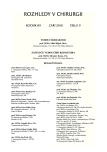Augmentation of Decompressive Craniectomy Using COM 30 Bandage in the Treatment of Refractory Intracranial Hypertension
Authors:
V. Přibáň *; O. Teplý **; R. Cihlář ***
Authors‘ workplace:
*1. Neurochirurgické oddělení Nemocnice České Budějovice, primář MUDr. Vladimír Chlouba, 2. Neurochirurgická klinika LF MU Brno, přednosta prof. MUDr. M. Smrčka Ph. D.
; Neurochirurgické oddělení Nemocnice České Budějovice, primář MUDr. Vladimír Chlouba
**; Anesteziologicko-resuscitační oddělení Nemocnice České Budějovice
***
Published in:
Rozhl. Chir., 2010, roč. 89, č. 9, s. 536-539.
Category:
Monothematic special - Original
Overview
Authors present case-report of 29-year old man with acute subdural hematoma and contusions in right basal frontotemporal area. Despite adequate conservative treatment and surgical therapy (hematoma evacuation and decompressive craniectomy) uncontrollable intracranial hypertension occurred 4th postoperative day. Situation has been effectively solved by resection of hemorrhagic temporal muscle together with duroplasty (fascia lata) and skin plastics using combined dressing fabric COM 30. Fabric was removed after eleven days followed skin suturing. Clinical status after four months is favorable, the patient is without neurological deficit. Bone flap return is planned.
Key words:
brain injury – intracranial hypertension – decompressive craniectomy – combined dressing fabric COM 30
Sources
1. Miller, J. D., Becker, D. P., Ward J. D. Significance of intracranial hypertension in severe head injury. J. Neurosurg., 1977; 47: 503–516.
2. Marmarou, A., Anderson, R. L., Ward, J. D., et al. Impact of ICP instability and hypotension on outcome in patients with severe head trauma. J. Neurosurg. (Suppl.), 1991; 75: 59–66.
3. Marshall, L. F., Smith, R. W., Shapiro, R. M. The outcome with agressive treatment in severe head injuries. The significance of intracranial pressure monitoring. J. Neurosurg., 1979;50: 20–26.
4. Langfitt, T. W., Kassell, N. F. Non-filling of cerebral vessels during angiography: Correlation with intracranial pressure. Acta Neurochir., 1966;14: 96–98.
5. Smrčka, M., et al. Poranění mozku. Praha, Grada, 2001.
6. Aarabi, B., Hesdorffer, D. C., Ahn, E. S., et al. Outcome following decompressive craniectomy for malignant swelling due to severe head injury. J. Neurosurg., 2006; 104: 469–479.
7. Navrátil, L. Dekompresivní kraniektomie u kraniocerebrálních poranění – hodnocení přežití a jeho kvality po jednom roce od úrazu. Čes. Slov. Neurol. Neurochir., 2007; 3: 294–301.
8. Compagnone, C. H., Murray, G., Teasdale, G., et al. The management of patients with intradural post-trauamatic mass lesions: A multicenter survey of current approaches to surgical management in 729 patients coordinated by the European Brain Injury Consortium. Neurosurgery, 2005; 57: 1183–1192.
9. Přibáň, V., Řehoušek, P., Fiedler, J. Postavení dekompresivní kraniektomie v chirurgické léčbě mozkových poranění – zhodnocení výsledků z období 2002–2004. Úrazová chirurgie, 2008; 16: 27–33.
10. Whitfield, P. C., Patel, H., Hutchinson, P. J., Czosnyka, M., Parry, D., Menon, D., et al. Bifrontal decompressive craniectomy in the management of posttraumatic intracranial hypertension. Br. J. Neurosurg., 200l; 15: 500–507.
11. Yamakami, I., Yamamura, A. Effects of decompressive craniectomy on regional cerebral blood flow in severe head trauma patients. Neurol. Med. Chir., 1993; 33: 616–620.
12. Jaeger, M., Soehle M., Meixenbauer, J. Effects of decompressive craniectomy on brain tissue oxygen in patients with intracrainal hypertension. J. Neurol. Nerosurg. Psychiatry, 2003; 74: 513–515.
13. Kombinovaná obvazová textilie COM 30 VÚP a.s. Dostupné na www.vup.cz/img/prohlaseni/
14. COM 30-kombinovaná obvazová textilie – VÚP. Dostupné na www.vup.cz/kdetail.php?id=8820
Labels
Surgery Orthopaedics Trauma surgeryArticle was published in
Perspectives in Surgery

2010 Issue 9
Most read in this issue
- Rapid Infection of Bone and Soft Tissues of the Upper Extremity – Case Report
- Lymphadenectomy in Papillary Thyroid Cancer
- Post-traumatic Pseudocyst of the Spleen
- Radial Nerve Palsy Caused by a Nonunion of the Humeral Shaft – A Case Report
